Boreal Forest Multifunctionality Is Promoted by Low Soil Organic Matter Content and High Regional Bacterial Biodiversity in Northeastern Canada
Abstract
1. Introduction
2. Materials and Methods
2.1. Study Sites
2.2. Forest Polygons Sampling
2.3. Abiotic Measurements
2.4. Ecosystem Functions
2.5. Extraction and PCR Amplification
2.6. Multifunctionality and Microbial Diversity Indexes
2.7. Statistical Analysis
3. Results
3.1. Dimensions of the Ecosystem Functioning
3.2. Response of Ecosystem Functioning Dimensions to Microbial Biodiversity
3.3. Causal Effects of Biodiversity and Environment on Ecosystem Functioning
3.4. Microbial Biodiversity and the Multifunctionality of Boreal Forests
4. Discussion
4.1. Multifunctionality and Microbial Diversity
4.2. A Predominant Role of the Environment on Ecosystem Multifunctionality
4.3. Environmental Role in Determination of Microbial Biodiversity
5. Conclusions
Supplementary Materials
Author Contributions
Funding
Acknowledgments
Conflicts of Interest
References
- Clemmensen, K.E.; Bahr, A.; Ovaskainen, O.; Dahlberg, A.; Ekblad, A.; Wallander, H.; Stenlid, J.; Finlay, R.D.; Wardle, D.A.; Lindahl, B.D. Roots and Associated Fungi Drive Long-Term Carbon Sequestration in Boreal Forest. Science 2013, 339, 1615–1618. [Google Scholar] [CrossRef] [PubMed]
- Bradshaw, C.J.; Warkentin, I.G. Global estimates of boreal forest carbon stocks and flux. Glob. Planet. Chang. 2015, 128, 24–30. [Google Scholar] [CrossRef]
- Maestre, F.T.; Quero, J.L.; Gotelli, N.J.; Escudero, A.; Ochoa, V.; Delgado-Baquerizo, M.; García-Gómez, M.; Bowker, M.A.; Soliveres, S.; Escolar, C.; et al. Plant species richness and ecosystem multifunctionality in global drylands. Science 2012, 335, 214–218. [Google Scholar] [CrossRef] [PubMed]
- Delgado-Baquerizo, M.; Maestre, F.T.; Reich, P.B.; Jeffries, T.C.; Gaitan, J.J.; Encinar, D.; Berdugo, M.; Campbell, C.D.; Singh, B.K. Microbial diversity drives multifunctionality in terrestrial ecosystems. Nat. Commun. 2016, 7, 10541. [Google Scholar] [CrossRef] [PubMed]
- Li, J.; Delgado-Baquerizo, M.; Wang, J.-T.; Hu, H.-W.; Cai, Z.-J.; Zhu, Y.-N.; Singh, B.K. Fungal richness contributes to multifunctionality in boreal forest soil. Soil Biol. Biochem. 2019, 136, 107526. [Google Scholar] [CrossRef]
- Fierer, N.; Jackson, R.B. The diversity and biogeography of soil bacterial communities. Proc. Natl. Acad. Sci. USA 2006, 103, 626–631. [Google Scholar] [CrossRef] [PubMed]
- Luo, P.; Han, X.; Wang, Y.; Han, M.; Shi, H. Influence of long-term fertilization on soil microbial biomass, dehydrogenase activity, and bacterial and fungal community structure in a brown soil of northeast China. Ann. Microbiol. 2015, 65, 533–542. [Google Scholar] [CrossRef]
- Jing, X.; Sanders, N.J.; Shi, Y.; Chu, H.; Classen, A.T.; Zhao, K.; Chen, L.; Shi, Y.; Jiang, Y.; He, J.-S. The links between ecosystem multifunctionalityand above- and belowground biodiversity aremediated by climate. Nat. Commun. 2015, 6, 8159. [Google Scholar] [CrossRef]
- Delgado-Baquerizo, M.; Grinyer, J.; Reich, P.B.; Singh, B.K. Relative importance of soil properties and microbial community for soil functionality: Insights from a microbial swap experiment. Funct. Ecol. 2016, 30, 1862–1873. [Google Scholar] [CrossRef]
- Kendrick, B. The Fifth Kingdom, Mycologue Publications, 2nd ed.; Focus Information Group Inc.: Newburyport, MA, USA, 1992. [Google Scholar]
- Gobat, J.-M.; Aragno, M.; Matthey, W. Le sol vivant: Bases de pédologie - Biologie des sols; Presses polytechniques et universitaires romandes: Lausanne, Suisse, 2010. [Google Scholar]
- Rousk, J.; Bååth, E.; Brookes, P.C.; Lauber, C.L.; Lozupone, C.; Caporaso, J.G.; Knight, R.; Fierer, N. Soil bacterial and fungal communities across a pH gradient in an arable soil. ISME J. 2010, 4, 1340–1351. [Google Scholar] [CrossRef]
- Bertrand, J.-C.; Caumette, P.; Lebaron, P.; Matheron, R.; Normand, P. Écologie Microbienne: Microbiologie des milieux naturels et anthropisés; Presses universitaires de Pau et des Pays de l’Adour: Charenton-le-Pont, France, 2011. [Google Scholar]
- Delgado-Baquerizo, M.; Oliverio, A.M.; Brewer, T.E.; Benavent-González, A.; Eldridge, D.J.; Bardgett, R.D.; Maestre, F.T.; Singh, B.K.; Fierer, N. A global atlas of the dominant bacteria found in soil. Science 2018, 359, 320–325. [Google Scholar] [CrossRef] [PubMed]
- Pärtel, M. Local plant diversity patterns and evolutionary history at the regional scale. Ecology 2002, 83, 2361–2366. [Google Scholar] [CrossRef]
- Hengl, T.; Jesus, J.M.D.; Heuvelink, G.B.M.; Ruiperez, M.; Kilibarda, M.; Blagoti, A.; Shangguan, W.; Wright, M.N.; Geng, X.; Bauer-marschallinger, B.; et al. SoilGrids250m: Global gridded soil information based on machine learning. PLoS ONE 2017, 12, e0169748. [Google Scholar] [CrossRef] [PubMed]
- Husson, O. Redox potential (Eh) and pH as drivers of soil/plant/microorganism systems: A transdisciplinary overview pointing to integrative opportunities for agronomy. Plant Soil 2013, 362, 389–417. [Google Scholar] [CrossRef]
- Hector, A.; Bagchi, R. Biodiversity and ecosystem multifunctionality. Nature 2007, 448, 188–190. [Google Scholar] [CrossRef]
- Cardinale, B.J.; Matulich, K.L.; Hooper, D.U.; Byrnes, J.E.; Duffy, E.; Gamfeldt, L.; Balvanera, P.; O’Connor, M.I.; Gonzalez, A. The functional role of producer diversity in ecosystems. Am. J. Bot. 2011, 98, 572–592. [Google Scholar] [CrossRef]
- Blaxter, M.; Mann, J.; Chapman, T.; Thomas, F.; Whitton, C.; Floyd, R.; Abebe, E. Defining operational taxonomic units using DNA barcode data. Philos. Trans. R. Soc. B: Biol. Sci. 2005, 360, 1935–1943. [Google Scholar] [CrossRef]
- Hautier, Y.; Isbell, F.; Borer, E.T.; Seabloom, E.W.; Harpole, W.S.; Lind, E.M.; Macdougall, A.S.; Stevens, C.J.; Adler, P.B.; Alberti, J.; et al. Local loss and spatial homogenization of plant diversity reduce ecosystem multifunctionality. Nat. Ecol. Evol. 2018, 2, 50–56. [Google Scholar] [CrossRef]
- Loreau, M.; Naeem, S.; Inchausti, P.; Bengtsson, J.; Grime, J.P.; Hector, A.; Hooper, D.U.; Huston, M.A.; Raffaelli, D.; Schmid, B.; et al. Biodiversity and Ecosystem Functioning: Current Knowledge and Future Challenges. Science 2001, 294, 804–808. [Google Scholar] [CrossRef]
- Grman, E.; Zirbel, C.R.; Bassett, T.; Brudvig, L.A. Ecosystem multifunctionality increases with beta diversity in restored prairies. Oecologia 2018, 188, 837–848. [Google Scholar] [CrossRef]
- Kurz, W.; Shaw, C.; Boisvenue, C.; Stinson, G.; Metsaranta, J.; Leckie, D.; Dyk, A.; Smyth, C.; Neilson, E. Carbon in Canada’s boreal forest — A synthesis. Environ. Rev. 2013, 21, 260–292. [Google Scholar] [CrossRef]
- Boucher, D.; De Grandpré, L.; Kneeshaw, D.; St-Onge, B.; Ruel, J.-C.; Waldron, K.; Lussier, J.-M. Effects of 80 years of forest management on landscape structure and pattern in the eastern Canadian boreal forest. Landsc. Ecol. 2015, 30, 1913–1929. [Google Scholar] [CrossRef]
- Lauber, C.L.; Hamady, M.; Knight, R.; Fierer, N. Pyrosequencing-Based Assessment of Soil pH as a Predictor of Soil Bacterial Community Structure at the Continental Scale. Appl. Environ. Microbiol. 2009, 75, 5111–5120. [Google Scholar] [CrossRef] [PubMed]
- Seo, D.C.; Delaune, R.D. Effect of redox conditions on bacterial and fungal biomass and carbon dioxide production in Louisiana coastal swamp forest sediment. Sci. Total Environ. 2010, 408, 3623–3631. [Google Scholar] [CrossRef]
- Genevieve, L.; Pierre-Luc, C.; Roxanne, G.-T.; Amélie, M.; Danny, B.; Vincent, M.; Hugo, G.; Laperriere, G.; Chagnon, P.-L.; Giguère-Tremblay, R.; et al. Estimation of Fungal Diversity and Identification of Major Abiotic Drivers Influencing Fungal Richness and Communities in Northern Temperate and Boreal Quebec Forests. Forests 2019, 10, 1096. [Google Scholar] [CrossRef]
- Noggle, G.R.; Wynd, F.L. The determination of selected chemical characteristics of soil which affect the growth and composition of plants. Plant Physiol. 1941, 16, 39–60. [Google Scholar] [CrossRef]
- Détermination de la matière organique par incinération: Méthode de perte au feu (PAF); Centre d’expertise en analyse environnementale du Québec: Quebec, QC, Canada, 2003; pp. 1–9.
- Husson, O.; Husson, B.; Brunet, A.; Babre, D.; Alary, K.; Sarthou, J.-P.; Charpentier, H.; Durand, M.; Benada, J.; Henry, M. Practical improvements in soil redox potential (Eh) measurement for characterisation of soil properties. Application for comparison of conventional and conservation agriculture cropping systems. Anal. Chim. Acta 2016, 906, 98–109. [Google Scholar] [CrossRef]
- Robertson, G.P.; Coleman, D.C.; Bledsoe, C.S.; Sollins, P. Soil Structural and Other Physical Properties. Standard Soil Methods for Long-Term Ecological Research, 1; Oxford University Press, Inc.: New York, NY, USA, 1999; Volume 1, pp. 75–78. [Google Scholar]
- Gouvernement Ouvert. Available online: https://ouvert.canada.ca (accessed on 10 February 2019).
- Earth Explorer. Available online: http://earthexplorer.usgs.gov/ (accessed on 31 January 2019).
- Johnson, S.; Kuske, C.R.; Carney, T.D.; Housman, D.C.; Gallegos-Graves, L.V.; Belnap, J. Increased temperature and altered summer precipitation have differential effects on biological soil crusts in a dryland ecosystem. Glob. Chang. Biol. 2012, 18, 2583–2593. [Google Scholar] [CrossRef]
- Microplate Enzyme Assay Using Fluorescence Original. Available online: http://enzymes.nrel.colostate.edu/assets/nrel_files/projects/enzymes/docs/microplatefluorescenceassay20120109.pdf (accessed on 2 September 2017).
- Sinsabaugh, R.L.; Hill, B.H.; Shah, J.J.F. Ecoenzymatic stoichiometry of microbial organic nutrient acquisition in soil and sediment. Nature 2009, 462, 795–798. [Google Scholar] [CrossRef]
- Sinsabaugh, R.L.; Gallo, M.E.; Lauber, C.; Waldrop, M.P.; Zak, D.R. Extracellular Enzyme Activities and Soil Organic Matter Dynamics for Northern Hardwood Forests receiving Simulated Nitrogen Deposition. Biogeochemistry 2005, 75, 201–215. [Google Scholar] [CrossRef]
- Huyben, D.; Sun, L.; Moccia, R.; Kiessling, A.; Dicksved, J.; Lundh, T. Dietary live yeast and increased water temperature influence the gut microbiota of rainbow trout. J. Appl. Microbiol. 2018, 124, 1377–1392. [Google Scholar] [CrossRef] [PubMed]
- Afgan, E.; Baker, D.; Batut, B.; Beek, M.V.D.; Bouvier, D.; Čech, M.; Chilton, J.; Clements, D.; Coraor, N.; Grüning, B.A.; et al. The Galaxy platform for accessible, reproducible and collaborative biomedical analyses: 2018 update. Nucleic Acids Res. 2018, 46, W537–W544. [Google Scholar] [CrossRef]
- Koleff, P.; Gaston, K.J.; Lennon, J.J. Measuring beta diversity for presence-absence data. J. Anim. Ecol. 2003, 72, 367–382. [Google Scholar] [CrossRef]
- Byrnes, J.E.K.; Gamfeldt, L.; Isbell, F.; Lefcheck, J.S.; Griffin, J.N.; Hector, A.; Cardinale, B.J.; Hooper, D.U.; Dee, L.E.; Duffy, J.E. Investigating the relationship between biodiversity and ecosystem multifunctionality: Challenges and solutions. Methods Ecol. Evol. 2014, 5, 111–124. [Google Scholar] [CrossRef]
- Boker, S.; Neale, M.; Maes, H.; Wilde, M.; Spiegel, M.; Brick, T.; Spies, J.; Estabrook, R.; Kenny, S.; Bates, T.; et al. OpenMx: An Open Source Extended Structural Equation Modeling Framework. Psychometrika 2011, 76, 306–317. [Google Scholar] [CrossRef] [PubMed]
- Kutzbach, J.; Gallimore, R.; Harrison, S.; Behling, P.; Selin, R.; Laarif, F. Climate and biome simulations for the past 21,000 years. Quat. Sci. Rev. 1998, 17, 473–506. [Google Scholar] [CrossRef]
- Pasari, J.R.; Levi, T.; Zavaleta, E.S.; Tilman, D. Several scales of biodiversity affect ecosystem multifunctionality. Proc. Natl. Acad. Sci. USA 2013, 110, 10219–10222. [Google Scholar] [CrossRef]
- CLIMAP. Seasonal reconstructions of the earth’s surface at the last glacial maximum. Geological Society of America Map Chart Series, MC-36. 1981. [Google Scholar]
- Maire, V.; Wright, I.J.; Prentice, I.C.; Batjes, N.H.; Bhaskar, R.; Van Bodegom, P.M.; Cornwell, W.K.; Ellsworth, D.; Niinemets, Ü.; Ordonez, A.; et al. Global effects of soil and climate on leaf photosynthetic traits and rates. Glob. Ecol. Biogeogr. 2015, 24, 706–717. [Google Scholar] [CrossRef]
- Givnish, T.J. Ecological constraints on the evolution of plasticity in plants. Evol. Ecol. 2002, 16, 213–242. [Google Scholar] [CrossRef]
- Richardson, S.J.; Peltzer, D.A.; Allen, R.B.; McGlone, M.S.; Parfitt, R.L. Rapid development of phosphorus limitation in temperate rainforest along the Franz Josef soil chronosequence. Oecologia 2004, 139, 267–276. [Google Scholar] [CrossRef]
- Lambers, H.; Raven, J.A.; Shaver, G.R.; Smith, S.E. Plant nutrient-acquisition strategies change with soil age. Trends Ecol. Evol. 2008, 23, 95–103. [Google Scholar] [CrossRef] [PubMed]
- Sirén, G. On the development of spruce forests on raw humus sites in north Finland and its ecology. Acta For. Fenn. 1955, 62, 408. [Google Scholar] [CrossRef]
- Simard, M.; LeComte, N.; Bergeron, Y.; Bernier, P.Y.; Paré, D. Forest productivity decline caused by successional paludification of boreal soils. Ecol. Appl. 2007, 17, 1619–1637. [Google Scholar] [CrossRef] [PubMed]
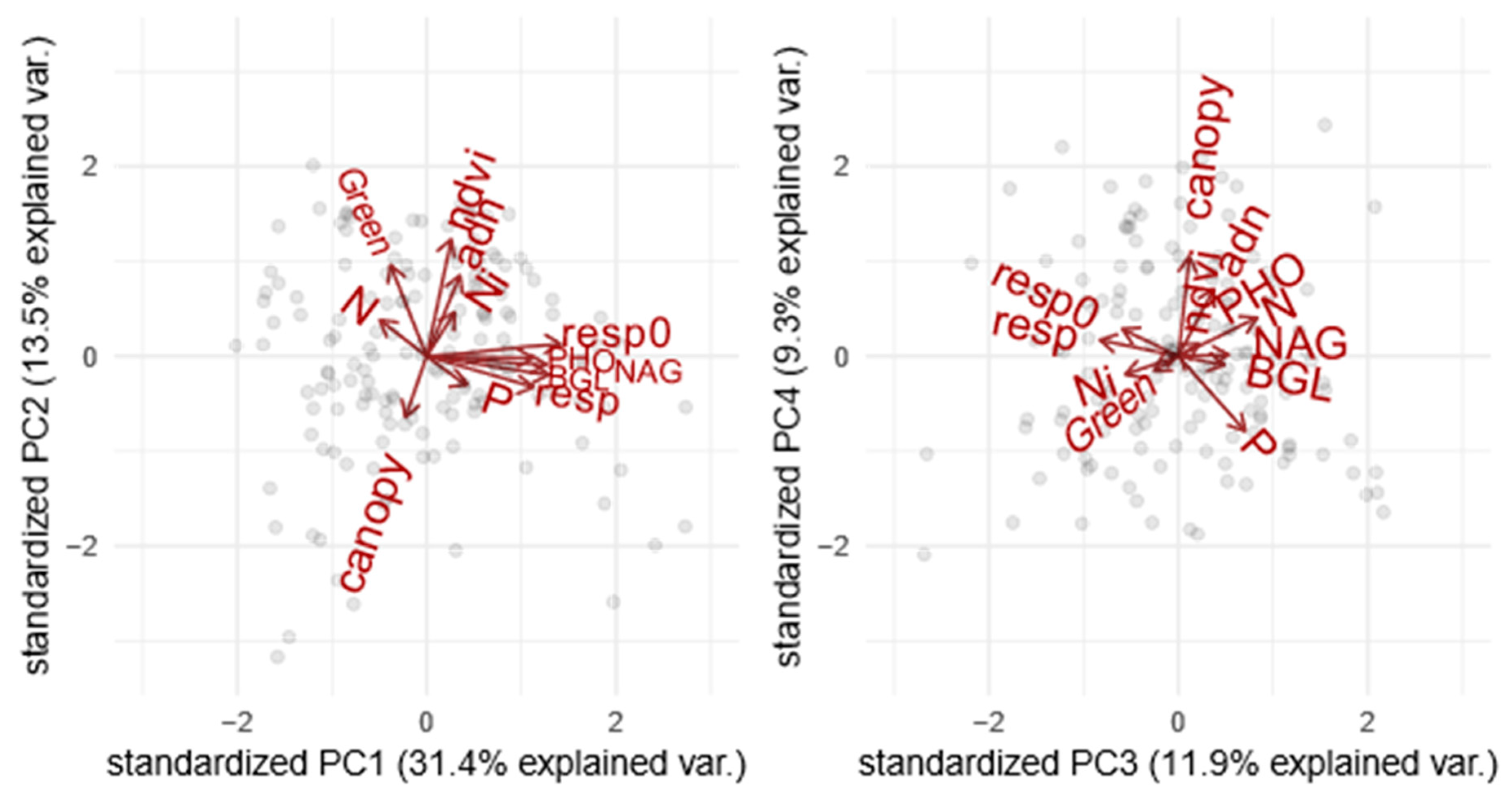
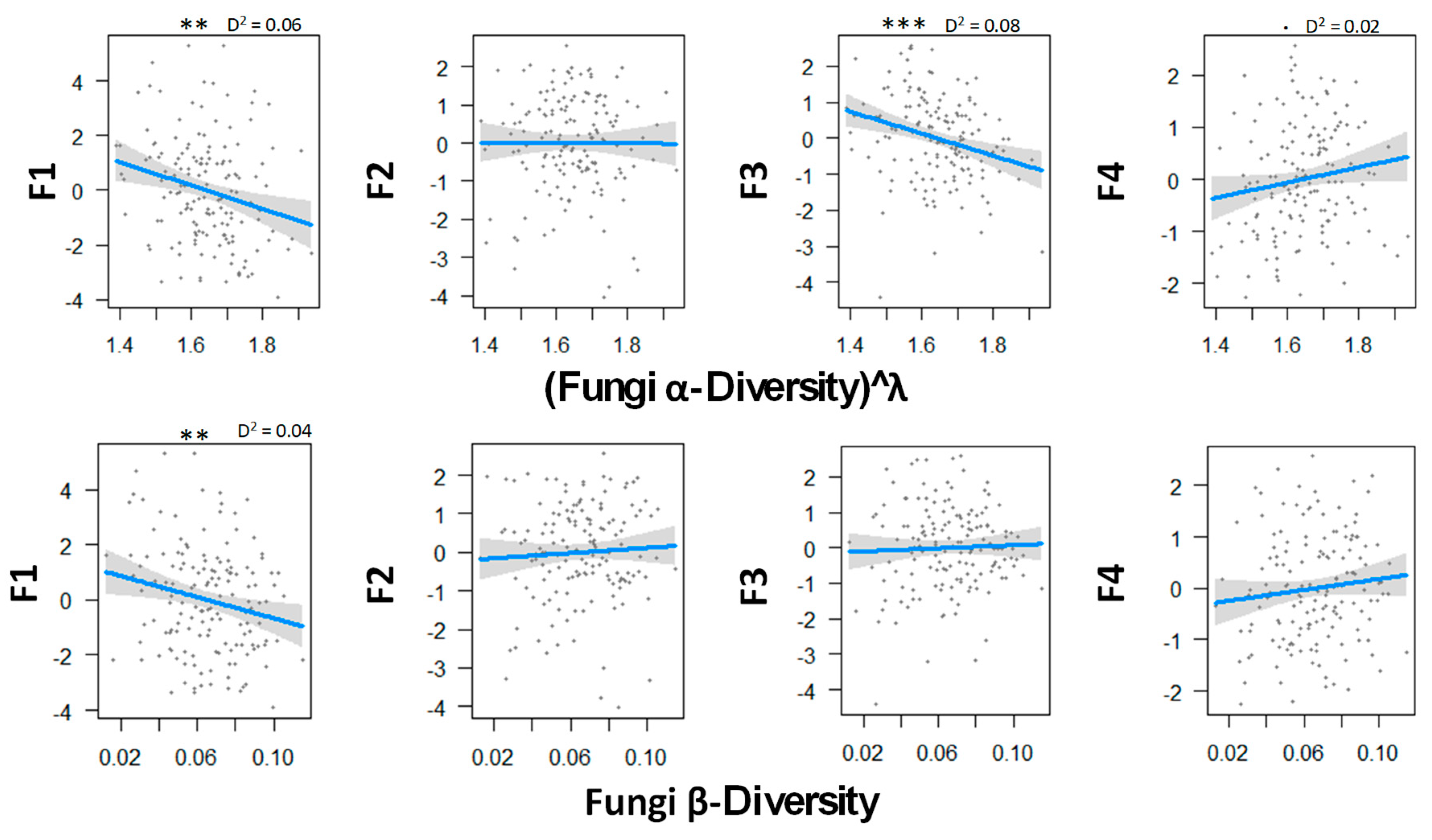
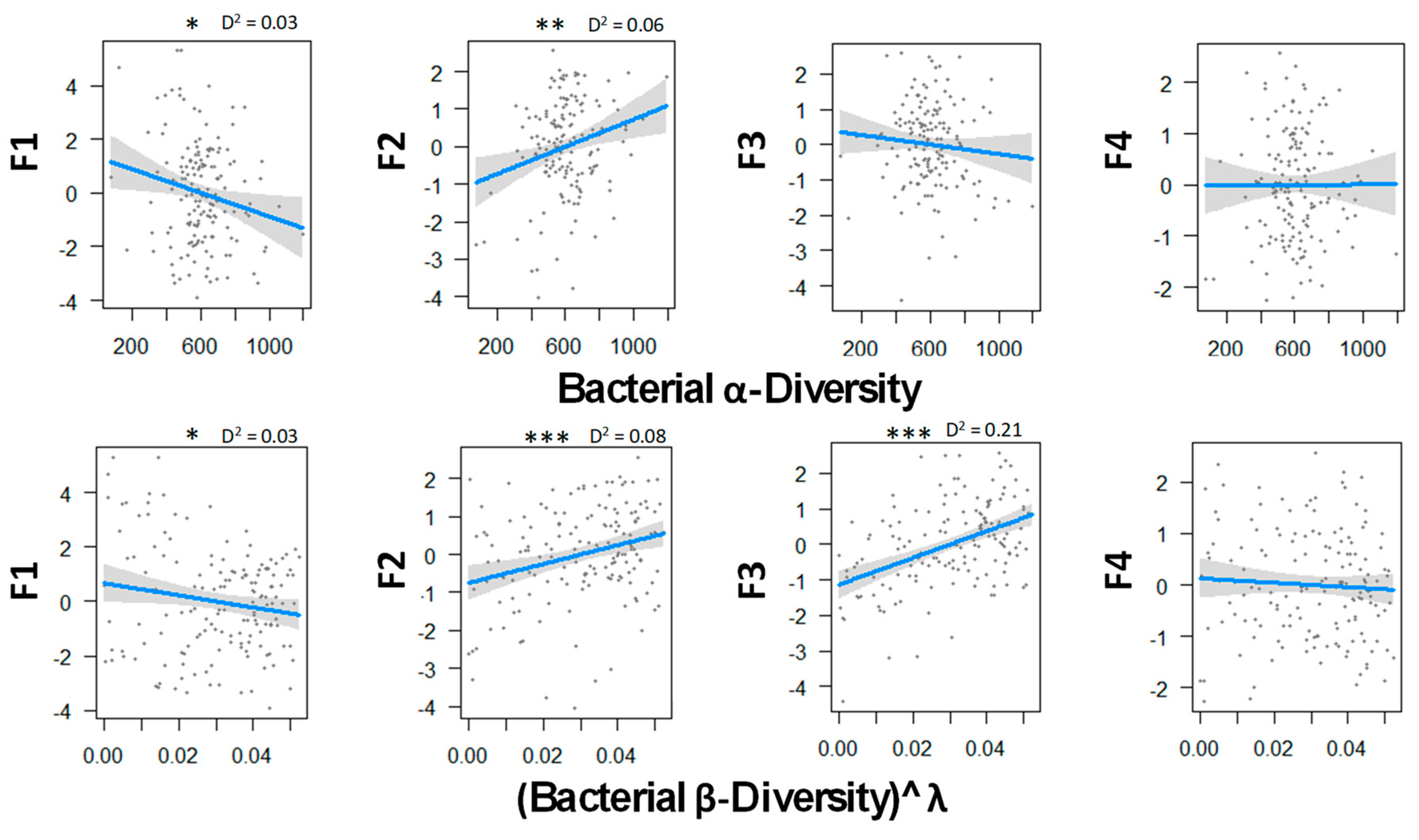
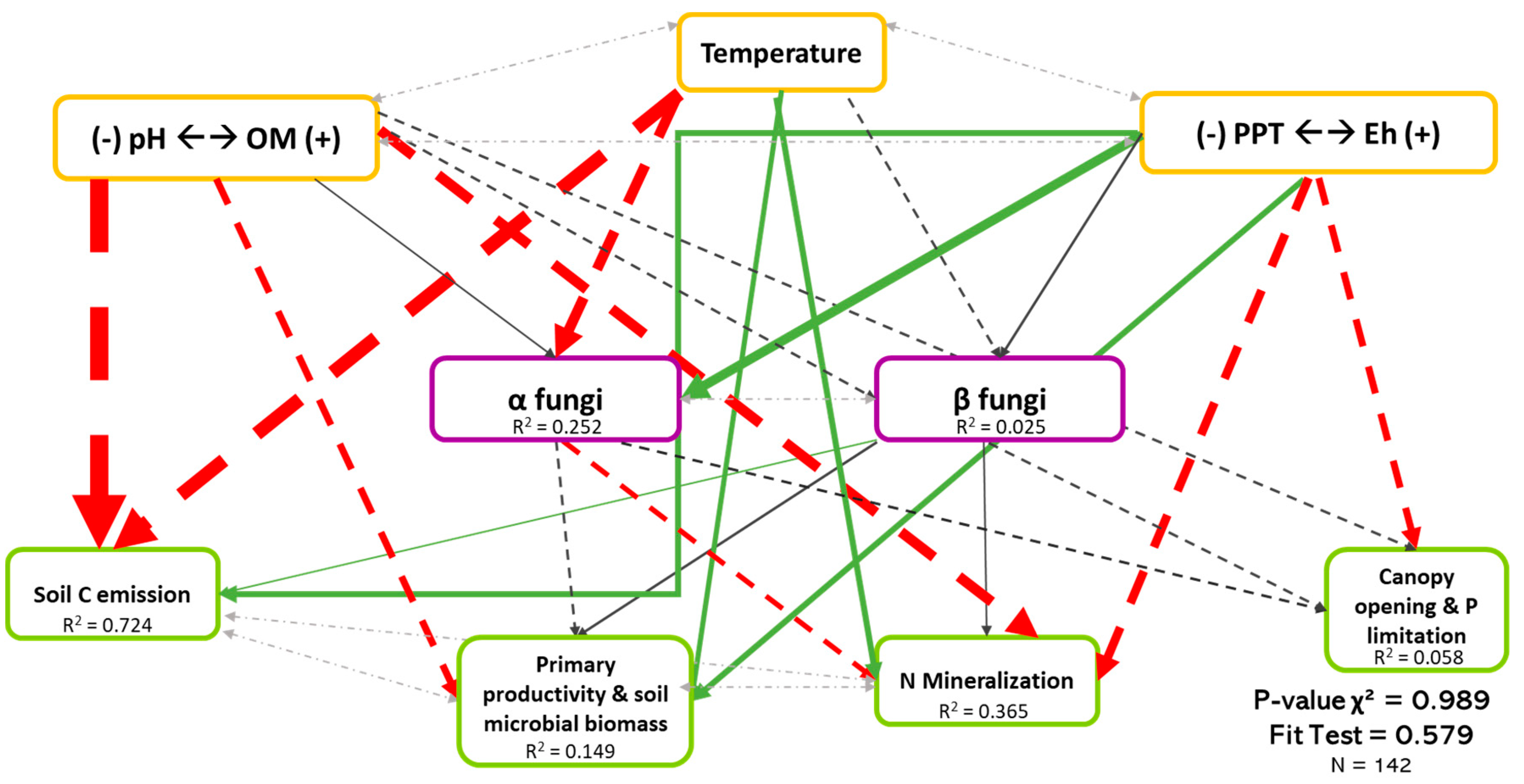
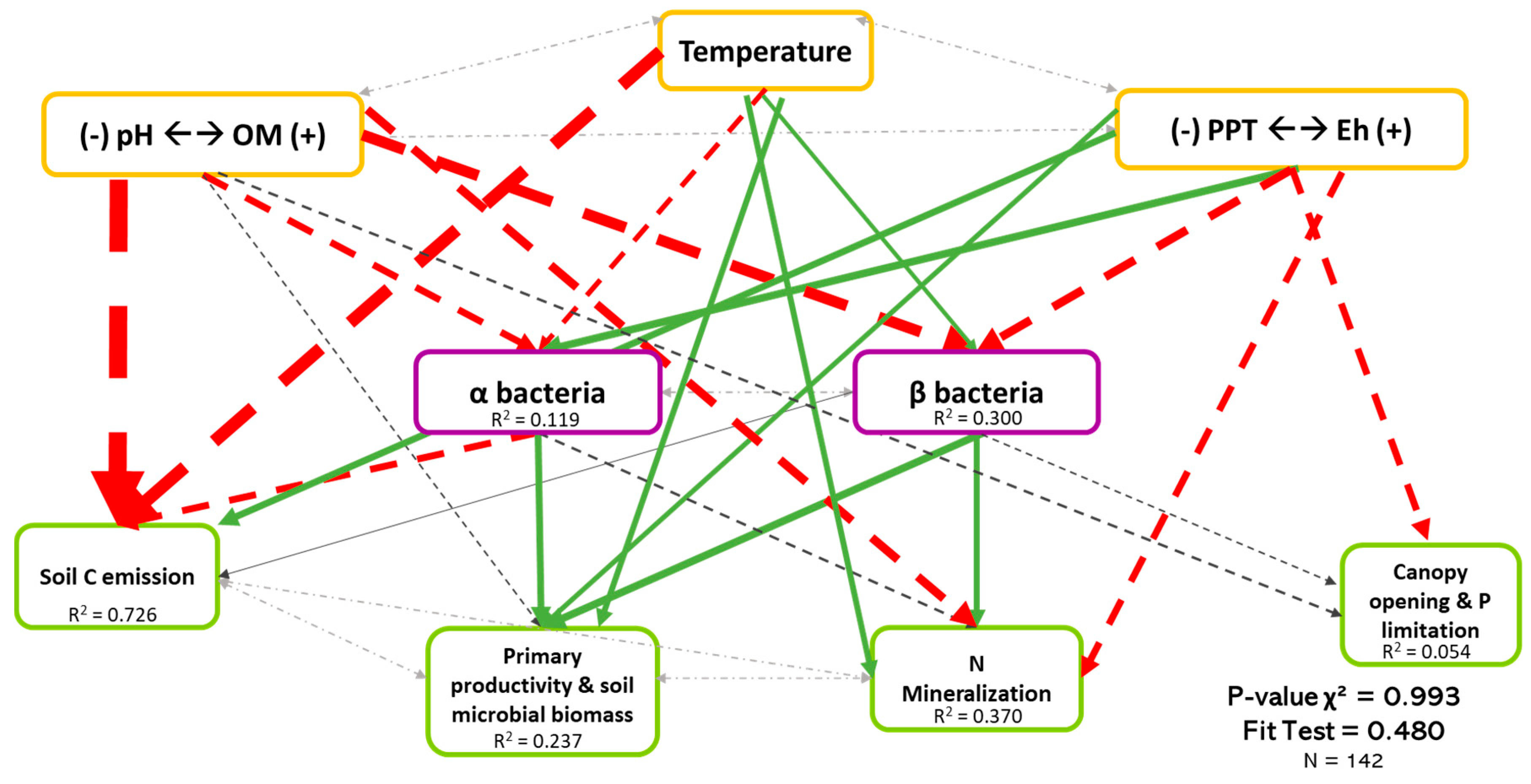
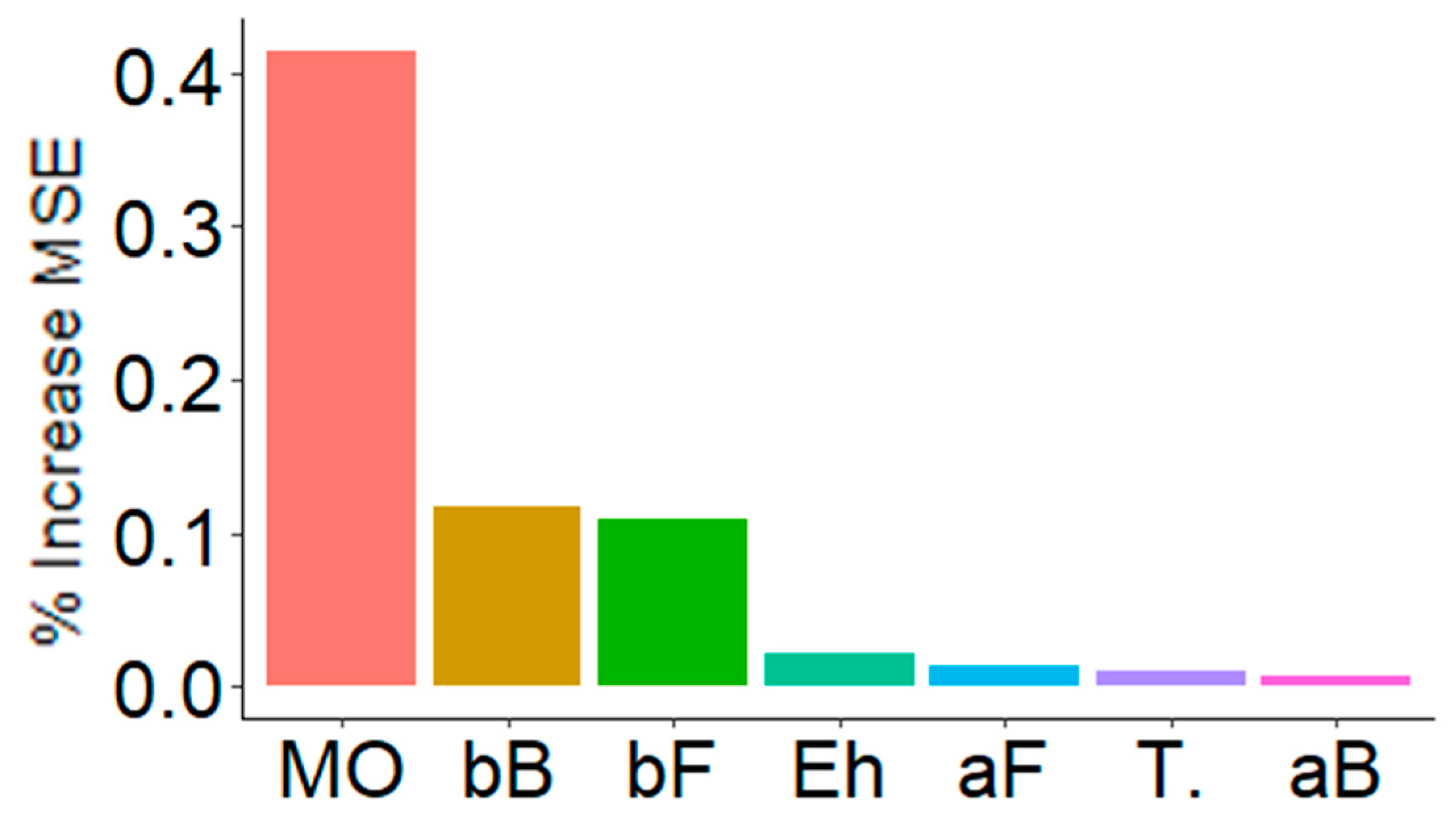
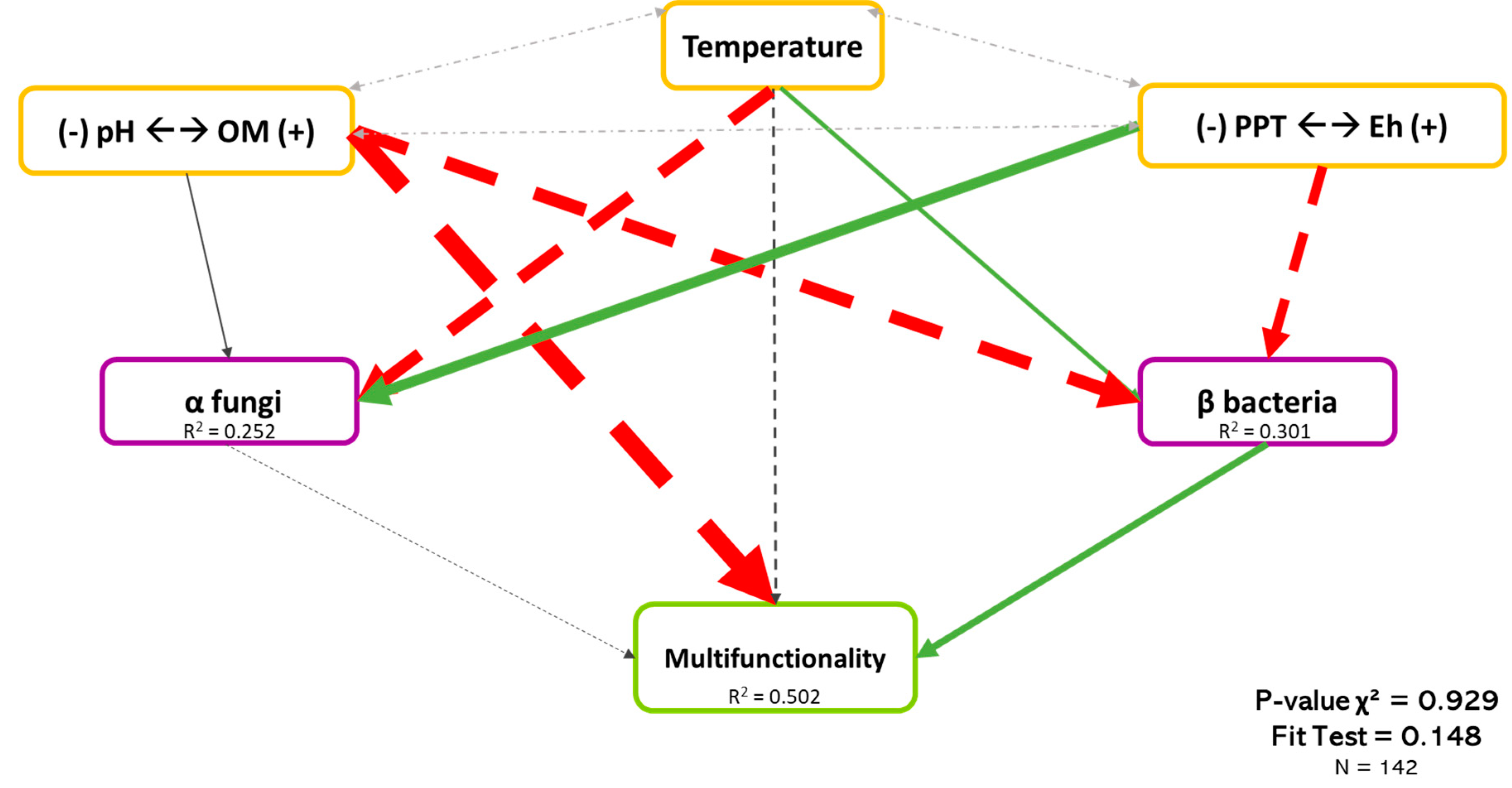
| Variables | Description | Type | Source |
|---|---|---|---|
| TEMP_MOY | Mean temperature, calculated with DJ0 and SC (°C). | Climate | E |
| PPT | Average cumulative precipitation during the growing season (mm) between 1974 and 2003. | Climate | E |
| DJ0 | Average base days 0 °C accumulated between April 1 and October 31 between 1979 and 2008 (days). | Climate | E |
| SC | Average length of the growing season (Tmoy ≥ 5.5 °C) based on the period 1979 to 2008 (days). | Climate | E |
| SGEL4 | Average length of the frost-free season (days) with a minimum temperature above a frost temperature threshold of −4 °C (1979–2008). | Climate | E |
| WHC | Water Holding Capacity. Maximum water retention of the soil. | Soil | M |
| Teau | Quantity of water present in the fresh soil one month after the sampling. | Soil | M |
| Poro | Porosity of the soil. Calculate using WHC and bulk density | Soil | C |
| WFP | Water-filled pore space | Soil | C |
| pH | Hydrogen potential. | Soil | M |
| Eh | Redox potential. | Soil | M |
| Mo | Soil organic matter measured by loss on ignition. | Soil | M |
| Variables | Description | Type | Source |
|---|---|---|---|
| BGL | Activity of the extracellular enzyme β-1,4-glucosidase (MUB release h−1 gsoil−1).It allows the breakdown of cellulose into glucose before being assimilated by microorganisms. | C cycle | M |
| NAG | Activity of the extracellular enzyme β-1,4-N-acetylglucosaminidase (MUB release h−1 gsoil−1). It allows the degradation of chitin. | N cycle | M |
| PHO | Activity of the extracellular enzyme acid phosphatase (MUB release h−1 gsoil−1). It allows the hydrolysis of phosphatases from phosphosaccharides and phospholipids. | P cycle | M |
| P | Quantity of phosphorus in the soil (mg Kg−1). Mehlich-III method was used. | P cycle | M |
| NDVI | Normalized difference vegetation index. Index sensitive to vigor and quantity of vegetation present. | Primary productivity | E |
| Canopy | Estimation of the openness of the canopy. “Quantity of visible sky in the plot”. | Primary productivity | E |
| Green | “Amount” index of chlorophyll present in the plot using photo taken under the canopy. | Primary productivity | E |
| Resp0 | Quantity of CO2 (ppm) emitted following preincubation of soil for 48hrs (T0). | C cycle | M |
| Resp | Maximum respiration rate (ppm gdriedsoil−1) of the soil measured for 12 days (T12). | C cycle | M |
| Ni | Amount of N initially present in soils prior to the 12-day mineralization incubation (mg Kg−1). | N cycle | M |
| Nmin | Mineralization rate following 12 days of incubation (mg Kg−1). | N cycle | M |
| ADN | Total amount of DNA found in soil composite (ADN gsoil−1). | Soil microbial biomass | M |
© 2020 by the authors. Licensee MDPI, Basel, Switzerland. This article is an open access article distributed under the terms and conditions of the Creative Commons Attribution (CC BY) license (http://creativecommons.org/licenses/by/4.0/).
Share and Cite
Giguère-Tremblay, R.; Laperriere, G.; de Grandpré, A.; Morneault, A.; Bisson, D.; Chagnon, P.-L.; Germain, H.; Maire, V. Boreal Forest Multifunctionality Is Promoted by Low Soil Organic Matter Content and High Regional Bacterial Biodiversity in Northeastern Canada. Forests 2020, 11, 149. https://doi.org/10.3390/f11020149
Giguère-Tremblay R, Laperriere G, de Grandpré A, Morneault A, Bisson D, Chagnon P-L, Germain H, Maire V. Boreal Forest Multifunctionality Is Promoted by Low Soil Organic Matter Content and High Regional Bacterial Biodiversity in Northeastern Canada. Forests. 2020; 11(2):149. https://doi.org/10.3390/f11020149
Chicago/Turabian StyleGiguère-Tremblay, Roxanne, Genevieve Laperriere, Arthur de Grandpré, Amélie Morneault, Danny Bisson, Pierre-Luc Chagnon, Hugo Germain, and Vincent Maire. 2020. "Boreal Forest Multifunctionality Is Promoted by Low Soil Organic Matter Content and High Regional Bacterial Biodiversity in Northeastern Canada" Forests 11, no. 2: 149. https://doi.org/10.3390/f11020149
APA StyleGiguère-Tremblay, R., Laperriere, G., de Grandpré, A., Morneault, A., Bisson, D., Chagnon, P.-L., Germain, H., & Maire, V. (2020). Boreal Forest Multifunctionality Is Promoted by Low Soil Organic Matter Content and High Regional Bacterial Biodiversity in Northeastern Canada. Forests, 11(2), 149. https://doi.org/10.3390/f11020149





